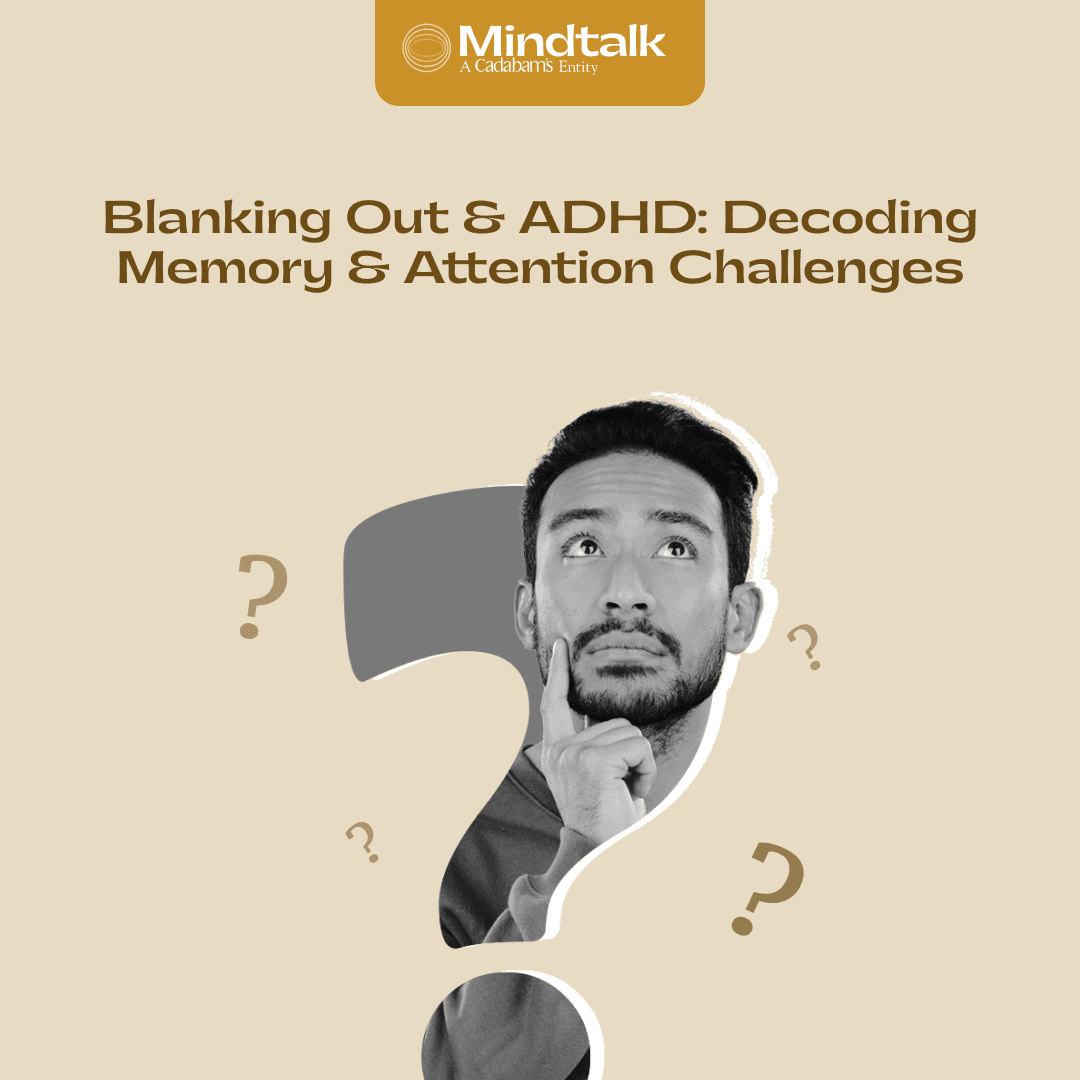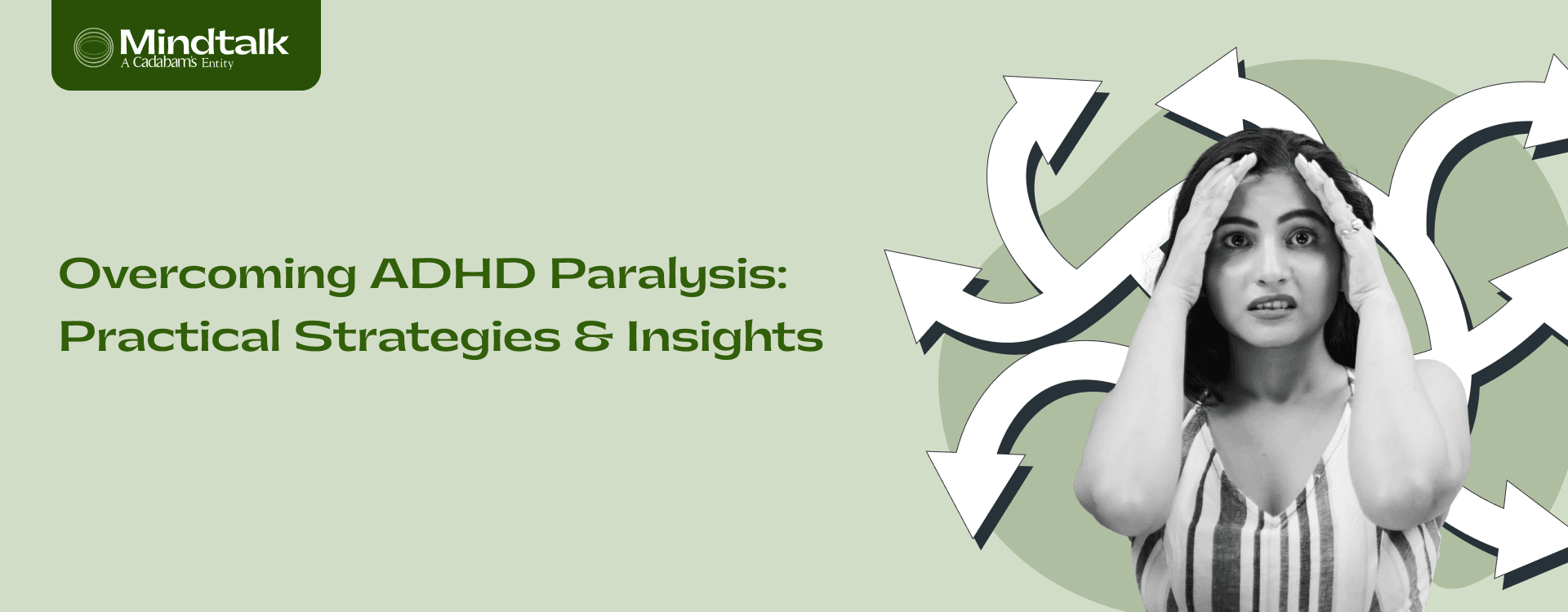Blanking Out and ADHD: How They’re Connected

Have you ever been in mid-conversation only to realize your mind has suddenly gone adrift? Your gaze is fixed, but your ears haven't registered a word for the last minute. You're not asleep, just... blank. We've all experienced this fleeting disconnect, but for some, it's a frequent, even debilitating occurrence. And if you struggle with Attention Deficit Hyperactivity Disorder (ADHD), this "blanking out" might be more than just a momentary lapse.
ADHD isn't new, but understanding its nuances is still evolving. With an increased focus on mental health and a growing awareness of ADHD's diverse forms, more individuals are recognizing their own "blanking out" episodes. Additionally, the rapidly stimulating world we live in, filled with constant distractions and information overload, can exacerbate these challenges for individuals with ADHD.
The culprit behind this mental fog is the wiring of the brain. In ADHD, specific brain regions responsible for attention and executive function (like planning and organizing) tend to show reduced activity or connectivity. This makes it harder to filter out distractions, sustain focus, and maintain task awareness. As a result, the mind can wander off involuntarily, leading to those frustrating blank spaces in conversations or work tasks.
This isn't just a minor inconvenience. Frequent blanking out can impact self-esteem, academic performance, and social relationships. It can feel isolating and frustrating, causing individuals to doubt their own abilities. This is where understanding the link between ADHD and blanking out becomes crucial. It's not about laziness or lack of effort but a neurological difference that requires support and effective management strategies.
Whether you suspect ADHD in yourself or someone you know, seeking professional guidance is key. Mental health professionals can provide accurate diagnoses, tailored treatment plans, and practical tools to manage attention and reduce "blanking out" episodes. Remember, with the right support, even the foggiest minds can find their focus and thrive.
Blank Out And ADHD—An Overview Of The
Attention-Deficit Hyperactivity Disorder (ADHD) is a neurodevelopmental condition characterized by persistent challenges in maintaining sustained attention, regulating impulses, and managing hyperactivity. On the other hand, "blanking out" refers to transient lapses in cognitive focus, often resulting in a momentary disconnect from the present.
The link between these phenomena lies in the intricate interplay of neurological factors and the demanding nature of contemporary lifestyles, where ADHD tendencies can manifest through episodes of mental disengagement.
Causes Of Blank Out In ADHD
In ADHD, fatigue amplifies cognitive struggles, intensifying "blankout" episodes. The constant mental effort to focus heightens vulnerability to drug misuse, offering a temporary escape but exacerbating cognitive challenges. The convergence of fatigue and substance misuse underscores the critical need for targeted interventions to address the unique challenges faced by individuals navigating ADHD-related "blankouts."
Fatigue
In individuals with ADHD, the intricate relationship between mental fatigue and cognitive blank outs manifests uniquely. Prolonged cognitive effort, typical in ADHD, taxes the brain's executive functions. This heightened cognitive load, coupled with the brain's struggle to filter irrelevant stimuli, can lead to mental exhaustion. Dopamine, crucial for attention regulation, faces disruptions. As fatigue sets in, attention falters, contributing to cognitive blanks.
Drug Misuse
The misuse of stimulant medications, commonly prescribed for ADHD, introduces paradoxical effects. Beyond the prescribed dose, these medications can disrupt neural circuits, leading to cognitive lapses. Additionally, self-medication practices with substances like nicotine, prevalent among ADHD individuals, interact with neurotransmitter systems, amplifying the risk of blank outs in ADHD.
The complex interplay involves norepinephrine and acetylcholine imbalances, impacting attention regulation. Furthermore, non-prescription stimulant use, often fueled by a desire to enhance focus, can intensify cognitive fatigue and increase the likelihood of blank outs.
Signs Of Blackout In ADHD
Inattention: Focus falters, attention wandering amid a sea of stimuli. A constant influx of distractions obscures crucial details, making them evade notice. Tasks unravel as sustained concentration proves challenging, with intermittent lapses in awareness and a struggle to maintain cognitive engagement.
Impulsivity: Hasty actions mark decision-making, which lacks measured consideration. Spontaneous choices replace the usual pause for thoughtful evaluation, diminishing it. The consequences of impulsive actions often unfold without prior contemplation, revealing a tendency to act on immediate urges without fully assessing the potential outcomes.
Hyperactivity: A surplus of energy manifests as restlessness, driving a constant need for movement and activity. Fidgeting and an inability to remain still become prominent, reflecting an internal motor seemingly unaffected by external attempts to maintain composure. This surplus energy often leads to an involuntary display of perpetual motion and physical restlessness.
The Phenomenon Of Blanking Out In ADHD
In the context of ADHD, "blanking out" often occurs during moments of inattention. This lapse manifests in various stages, with the primary states being predominantly inattentive, hyperactive-impulsive, or combined presentations. During periods of inattention in ADHD, individuals may experience blanking out, where focus wavers and external stimuli override cognitive engagement.
This may appear as zoning out, daydreaming, or a temporary disconnect from the surroundings. Neural dysregulation in the prefrontal cortex, implicated in attention and impulse control, contributes to these lapses. It's crucial to recognize these manifestations to tailor interventions that enhance sustained attention and mitigate the impact of ADHD symptoms on daily functioning.
Mechanisms Of Forgetting Unpleasant Memories
In ADHD, the forgetting of distressing memories, akin to blanking out, involves intricate processes. Imagine a mental filter. Emotionally charged memories, especially distressing ones, may become less clear. Signs include moments when specific details of these memories temporarily fade. It's like a brief mental pause.
Inside the brain, the collaboration between the memory-forming hippocampus and the emotion-regulating amygdala is crucial. In ADHD, this partnership might not always function optimally, resulting in a softening of the impact of harsh memories.
Real-Life Implications And Challenges
Real-life challenges arise when individuals with ADHD experience blank outs, disrupting tasks that demand sustained attention, particularly in complex or monotonous activities, adversely affecting productivity. This phenomenon extends its impact to academic settings, affecting learning and exam performance for students while adults grapple with challenges in professional environments, leading to errors and missed deadlines.
The occurrence of blank outs in ADHD is not limited to specific scenarios; they can strike during meetings, conversations, or reading, exacerbated by stress, fatigue, or sensory overload. The productivity impact is significant, hindering task completion, disrupting workflows, and contributing to forgetfulness, thereby compromising work quality and potentially straining relationships while eroding self-esteem. Coping strategies involve implementing structured routines, breaking tasks into smaller steps, utilizing reminders, and incorporating frequent breaks.
Coping Mechanism And Mental Health
Blanking out in ADHD significantly impacts mental health by disrupting daily functioning, hindering communication, and straining relationships. Persistent forgetfulness contributes to heightened stress and frustration, along with the cognitive effort to compensate for memory lapses leading to mental fatigue. Coping mechanisms are crucial in addressing these challenges. Tailored strategies include structured routines, visual aids, and reminders to enhance focus and memory.
Cognitive-behavioral techniques, such as mindfulness, foster present-focused attention. Addressing underlying stressors is pivotal for reducing lapses. Implementing these coping mechanisms helps individuals with ADHD navigate the impact of blanking out, fostering improved mental well-being and effective coping strategies.
How To Manage ADHD Forgetfulness
Navigating ADHD forgetfulness requires innovative strategies. Establish routines, utilize reminders or apps, break tasks into manageable steps, and create a dedicated space for essentials. Embrace techniques tailored to individual needs, fostering a structured and supportive environment for improved focus and memory.
Mnemonics
In the realm of managing ADHD-related blanking out or forgetfulness, mnemonics emerge as a powerful cognitive tool. Picture crafting vivid mental associations or employing acronyms tailored to the information at hand. For instance, visualize a memorable scene connected to a specific detail you want to remember.
Crafting an acronym using the initial letters of key information embeds it in memory. To enhance effectiveness, engage multiple senses—associate a distinct smell or sound with the information.
Play Games
Opt for strategic games like chess or puzzles that stimulate cognitive functions, enhancing focus and memory. Incorporate video games designed to boost attention and executive functions. Gamify daily tasks with point systems or timers, transforming routine activities into engaging challenges.
Explore memory card games or apps specifically tailored to memory enhancement, providing a fun and interactive way to sharpen recall abilities. The blend of entertainment and cognitive exercise in these game-centric strategies contributes to a proactive, enjoyable ADHD management approach, fostering mental agility and resilience.
Tools For Organization
Invest in digital planners or apps with customizable reminders to structure daily activities. Leverage color-coded calendars for visual clarity, assigning specific hues to distinct tasks or deadlines. Employ task management tools that break down responsibilities into manageable steps, minimize overwhelm, and set auditory cues for crucial reminders. Additionally, you can utilize physical tools like labeled storage bins or designated bulletin boards for visual cues.
Medication
Stimulant medications take the forefront in cases of blanking out or forgetfulness linked to ADHD. Falling under the class of amphetamines and methylphenidates, these drugs simplify neurotransmitter activity in the brain, enhancing attention and focus. Non-stimulant options like atomoxetine target norepinephrine receptors, providing an alternative for those with stimulant sensitivities. alpha-2 adrenergic agonists offer a non-stimulant avenue by modulating certain neurotransmitters.
These classes of medications, prescribed based on individual needs and responses, contribute to a multifaceted approach to mitigating ADHD symptoms, including forgetfulness and cognitive lapses, fostering a balanced and targeted intervention strategy.
Therapy Options For Memory And Attention Management
For memory optimization and attention management, explore neurofeedback, which helps in reshaping neural pathways. Engaging in cognitive training exercises emphasizing sustained attention tasks has been known to help. Professionals often incorporate mindfulness techniques, grounding attention in the present moment. Dietary adjustments like omega-3 fatty acids enhance cognitive function. Adequate sleep also solidifies memory consolidation. Additionally, CBT strategies tackle negative thought patterns affecting attention.
Learn How To Overcome Memory Attention And Its Challenges With Mindtalk.
Embark on a transformative journey to conquer memory and attention challenges at Mindtalk. Explore neuroplasticity exercises, honing synaptic connections crucial for memory retention. Leverage attention-boosting, such as focused breathing, to anchor awareness in the present moment.
Uncover the potency of dual-n-back training, which dynamically enhances working memory. We help you implement strategic lifestyle adjustments, optimizing sleep architecture and nutrition to fuel cognitive vitality. Mindtalk seamlessly these tailored strategies, creating a holistic approach for overcoming memory and attention hurdles.










